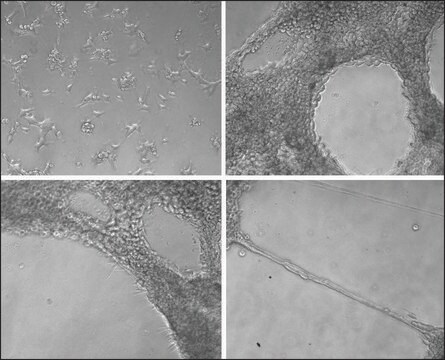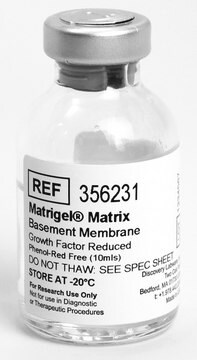ECM205
Millicoat® ECM Screening Kit, 1 ea. ECM101-ECM105
Millicoat®, pkg of 96-well plate(s) (for fibronectin, vitronectin, laminin, collagen I & collagen IV)
Synonym(s):
Formerly under the CytoMatrix brand name.
About This Item
Recommended Products
species reactivity
human
Quality Level
manufacturer/tradename
Chemicon®
Millicoat®
packaging
pkg of 96-well plate(s) (for fibronectin, vitronectin, laminin, collagen I & collagen IV)
technique(s)
activity assay: suitable
cell based assay: suitable
input
sample type neural stem cell(s)
sample type: human embryonic stem cell(s)
sample type: mouse embryonic stem cell(s)
sample type epithelial cells
sample type hematopoietic stem cell(s)
sample type pancreatic stem cell(s)
sample type induced pluripotent stem cell(s)
sample type mesenchymal stem cell(s)
detection method
colorimetric
shipped in
wet ice
General description
Application
NOTE: Optimal assay performance is obtained using subconfluent cell cultures. This can be achieved by splitting the cells 1 to 2 days prior to performing the assay.
1. Rehydrate the strips with 200 mL of PBS per well for at least 15 minutes at room temperature. Remove the PBS from the rehydated strips.
2. Prepare a single cell suspension, preferably using a non-enzymatic dissociation buffer. Optimum cell density may be determined by titration of the cells. A common starting range is between 1x10E05 to 1x10E07 cells/mL.
3. Add 100 mL of the diluted cell suspension to each well. Incubate the plate at 37°C for 1 hour in a CO2 incubator. Gently wash the plate 3 times with PBS containing Ca2+/Mg2+ (200 mL/well).
4. Add 100 mL/well of 0.2% crystal violet in 10% ethanol to each well. Incubate for 5 minutes at room temperature. Remove the stain from the wells. Gently wash the plate 3 times with PBS (300 mL/well).
5. Add 100 mL of Solubilization Buffer (A 50/50 mixture of 0.1M NaH2PO, pH 4.5 and 50% ethanol) to each well. Allow strips to incubate and gently shake at room temperature until the cell-bound stain is completely solubilized; approximately 5 minutes.
6. Determine the absorbances at 540 - 570 nm on a microplate reader.
Cell Structure
Storage and Stability
Legal Information
Disclaimer
Storage Class Code
11 - Combustible Solids
Certificates of Analysis (COA)
Search for Certificates of Analysis (COA) by entering the products Lot/Batch Number. Lot and Batch Numbers can be found on a product’s label following the words ‘Lot’ or ‘Batch’.
Already Own This Product?
Find documentation for the products that you have recently purchased in the Document Library.
Articles
Extracellular matrix proteins such as laminin, collagen, and fibronectin can be used as cell attachment substrates in cell culture.
Related Content
This page covers the ECM coating protocols developed for four types of ECMs on Millicell®-CM inserts, Collagen Type 1, Fibronectin, Laminin, and Matrigel.
Our team of scientists has experience in all areas of research including Life Science, Material Science, Chemical Synthesis, Chromatography, Analytical and many others.
Contact Technical Service



